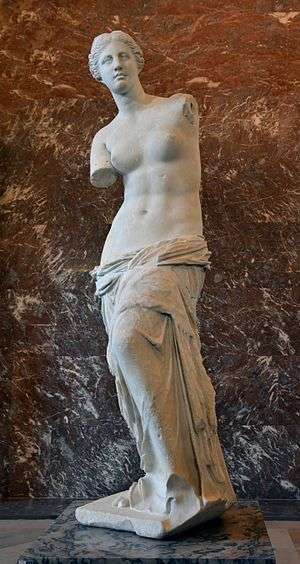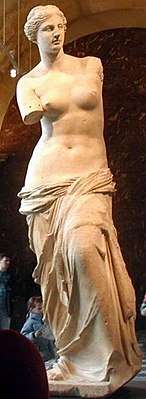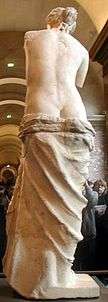Venus de Milo
| Venus de Milo | |
|---|---|
| Greek: Αφροδίτη της Μήλου | |
 | |
| Artist | Alexandros of Antioch |
| Year | Between 130 and 100 BC |
| Type | Marble |
| Dimensions | 203 cm (80 in) |
| Condition | Arms broken off; otherwise intact |
| Location | Louvre Museum, Paris, France |
| 48°51′36″N 2°20′14″E / 48.859958°N 2.337269°ECoordinates: 48°51′36″N 2°20′14″E / 48.859958°N 2.337269°E | |
The Aphrodite of Milos (Greek: Αφροδίτη της Μήλου, Aphroditi tis Milou), better but mistakenly known as the Venus de Milo, is an ancient Greek statue and one of the most famous works of ancient Greek sculpture. Initially it was attributed to the sculptor Praxiteles, however from an inscription that was on its plinth, the statue is thought to be the work of Alexandros of Antioch. Created sometime between 130 and 100 BC, the statue is believed to depict Aphrodite, the Greek goddess of love and beauty; however, some scholars claim it is the sea-goddess Amphitrite, venerated on Milos.[1] It is a marble sculpture, slightly larger than life size at 203 cm (6 ft 8 in) high. Part of an arm and the original plinth were lost following its discovery. It is currently on permanent display at the Louvre Museum in Paris. The statue is named after the Greek island of Milos, where it was discovered.
Description
The Aphrodite of Milos is "widely renowned" for the mystery of her missing arms.[2] There is a filled hole below her right breast that originally contained a "metal tenon" that would have supported the separately carved right arm.
Discovery and history
It is generally asserted that the Aphrodite of Milos was discovered on 8 April 1820 by a peasant named Yorgos Kentrotas, inside a buried niche within the ancient city ruins of Milos, the current village of Tripiti, on the island of Milos (also Melos, or Milo) in the Aegean, which was then a part of the Ottoman Empire.[3]
Elsewhere the discoverers are identified as Yorgos Bottonis and his son Antonio. Paul Carus gave the site of discovery as "the ruins of an ancient theater in the vicinity of Castro, the capital of the island", adding that Bottonis and his son "came accidentally across a small cave, carefully covered with a heavy slab and concealed, which contained a fine marble statue in two pieces, together with several other marble fragments. This happened in February, 1820". He apparently based these assertions on an article he had read in the Century Magazine.[4]
The Australian historian Edward Duyker, citing a letter written by Louis Brest who was the French consul in Milos in 1820, asserts the discoverer of the statue was Theodoros Kendrotas and that he has been confused with his younger son Giorgios (known phonetically as Yorgos) who later claimed credit for the find. Duyker asserts that Kendrotas was taking stone from a ruined chapel on the edge of his property – terraced land that had once formed part of a Roman gymnasium – and that he discovered an oblong cavity some 1.2 x 1.5 metres deep in the volcanic tuff. It was in this cavity, which had three wings, that Kendrotas first noticed the upper part of the statue.[5]
Notwithstanding these anomalies, the consensus is that the statue was found in two large pieces (the upper torso and the lower draped legs) along with several herms (pillars topped with heads), fragments of the upper left arm and left hand holding an apple, and an inscribed plinth.




In 1871, during the Paris Commune uprising, many public buildings were burned. The Venus de Milo statue was secreted out of the Louvre Museum in an oak crate and hidden in the basement of the Prefecture of Police. Though the Prefecture was burned, the statue survived undamaged.[6]
In 1920, sculptor Robert Ingersoll Aitken created a stir when he criticized the display, lighting, and placement of the statue of Venus de Milo in the museum.[7]
In the autumn of 1939, the Venus was packed for removal from the Louvre in anticipation of the outbreak of war. Scenery trucks from the Comédie-Française transported the Louvre's masterpieces to safer locations in the countryside.[8] During World War II, the statue was sheltered safely in the Château de Valençay, along with the Winged Victory of Samothrace and Michelangelo's Slaves.[9]
The great fame of the Venus de Milo during the nineteenth century was not simply the result of its admitted beauty; it also owed much to a major propaganda effort by the French authorities. In 1815, France had returned the Medici Venus to the Italians after it had been looted by Napoleon Bonaparte. The Medici Venus, regarded as one of the finest classical sculptures in existence, caused the French to promote the Venus de Milo as a greater treasure than that which they recently had lost. The statue was praised dutifully by many artists and critics as the epitome of graceful female beauty. However, Pierre-Auguste Renoir was among its detractors, labeling it a "big gendarme".[10]
Modern use

The statue has greatly influenced masters of modern art; one prime example is Salvador Dalí's Venus de Milo with Drawers.
The statue was formerly part of the seal of the American Society of Plastic Surgeons (ASPS), one of the oldest associations of plastic surgeons in the world.[11]
In February 2010, the German magazine Focus featured a doctored image of this Venus giving Europe the middle finger, which resulted in a defamation lawsuit against the journalists and the publication.[12] They were found not guilty by the Greek court.[13]
A plot to steal the statue is at the center of the 1966 spoof spy film The Last of the Secret Agents?, starring Marty Allen and Steve Rossi.
In The Simpsons episode Homer Badman, a Gummi Venus de Milo parodies the statue.
See also
References
Citations
- ↑ https://www.louvre.fr/en/oeuvre-notices/aphrodite-known-venus-de-milo
- ↑ Curtis 2003.
- ↑ Venus de Milo at Encyclopædia Britannica
- ↑ Carus, Paul (1916). The Venus of Milo: An Archeological Study of the Goddess of Womanhood. Open Court Publishing Company. p. 2. Retrieved 6 April 2018.
- ↑ Duyker 2014, pp. 61–62.
- ↑ The Greater Journey, David McCullough, p.326
- ↑ "Criticises museum sculpture settings" (pdf). New York Times. 21 May 1920. Retrieved 30 January 2011.
- ↑ Nicholas 1995, p. 55
- ↑ Nicholas 1995, p. 87
- ↑ Bonazzoli, Francesca; Robecchi, Michele (2014). Mona Lisa to Marge: How the World's Greatest Artworks Entered Popular Culture. New York: Preste. ISBN 978-3791348773.
- ↑ Brent, Burt (2008). "The Reconstruction of Venus: Following Our Legacy". Plastic and Reconstructive Surgery. 121 (6): 2170. doi:10.1097/PRS.0b013e318170a7b6.
- ↑ "Greece Pursues Venus Defamation Case" Archived 7 December 2011 at the Wayback Machine., Diehn, Sonya Angelica Courthouse News Service. 1 December 2011
- ↑ "Greek Court acquits Focus journalists" Archived 15 July 2012 at the Wayback Machine.. Burda Newsroom, 3 April 2012
Sources
- Curtis, Gregory (2003). Disarmed: The Story of the Venus de Milo. New York: Alfred A. Knopf. ISBN 978-0375415234. OCLC 51937203.
- Duyker, Edward (2014). Dumont d’Urville: Explorer and Polymath. Dunedin, New Zealand: Otago University Press. ISBN 978-1877578700.
- Nicholas, Lynn H. (May 1995) [1994]. The Rape of Europa: The Fate of Europe's Treasures in the Third Reich and the Second World War. New York City: Vintage Books. ISBN 978-0-679-40069-1. OCLC 32531154.
- Venus de Milo: The Oxford Dictionary of Art
- James Grout, Venus de Milo, part of the Encyclopædia Romana